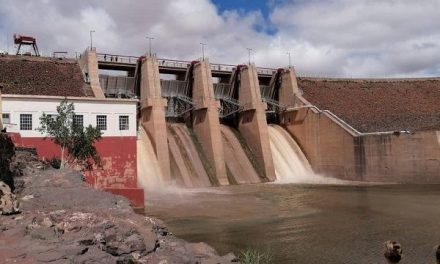
Overview for the week and 5-day outlook to Wednesday 18 April 2018

Visual: Change in soil moisture outlook for the next 8 days as of Friday 13 April
Source: GrADS/Cola, George Mason University, National Centers for Environmental Prediction
www.wxmaps.org/outlooks.php
What Happened
Following the anomalous synoptic pattern of last week, this week the weather returned to a more typical Namibian stance with the only exception being the continuing late rains.
During the week the South Atlantic high pressure cell followed its customary route around Cape Agulhas on its journey to the east. By Friday, it has morphed into the southern Indian high with its core situated about 1500 km south of Madagascar. This is its normal position and there were no Indian Ocean anomalies on the synoptic map.
In the meantime, the next South Atlantic high has approached the continent, initially slightly weaker than normal but by Friday back to its usual 1024 mB with the core just under 2000 km due west of Saldanha Bay. This is also its usual position although the overall synoptic pattern is closer to a mid-summer stance than what one would expect so late in the season.
The two most prominent features of this week was the low cloud base, typically around 8000 feet asl over the entire country except the coastal plain, and the absence of ridging, i.e. high pressure control in the upper layer between 30,000 and 45,000 feet. This is conducive for convection and over the interior (and on many weather pictures circulated on social media) the very high cloud tops were evident. For the first time this season, the majority of Namibia’s territory was covered, intermittently, by complex cumulonimbus (CB) cloud formations. The result was the good, enduring and widespread rains, accompanied by lots of thunder activity, also a rare occurrence in the earlier season.
Similar to last week, the bias was over the western half and the central high ground. It was only that part of Otjozondjupa along the Botswana border that did not share in the prolific rain.
From the Desert Lion Conservation project came the news that the northwestern quadrant received copious inland rain last week with widespread flooding and six of the nine ephemeral rivers in flood. The Huab actually broke through the sand barrier into the sea on 04 April. The project noted that this type of flooding was last experienced in 1995. This observation ties in with the overall development of the decad. The rain followed a wide mid-level trough visible from southern Angola across Namibia and Botswana into South Africa.
The Inter-tropical convergence zone has shifted by a few hundred kilometres as must be expected but the atmospheric moisture is still very high over Angola and Zambia. With a small, late summer push from the southern Indian high, this can still produce some late rain, a scenario which actually features on at least two outlooks for Sunday and Monday.
What’s Coming
The position of the South Atlantic high is slowly assuming a more winter-oriented stance compared to conditions of the past 40 days.
The 1020 mB isobar of the South Atlantic high makes landfall during Friday night, but the high itself is expected to slip around the continent.
This will create a typical damming effect, which opposes the flow and direction of the mid-level trough that continues to be present over Namibia. This usually leads to unexpectedly heavy falls from rather unpromising overall conditions.
Limited rainfall is indicated for Saturday over a large swathe running from the Kunene River mouth across the interior to Ariamsvlei. This same system develops to the west on Sunday and Monday, with good rainfall prospects for the western half, including the coastal plain, and for the Karas Region. Unexpectedly, the eastern parts along the Botswana border will miss out again.
The soil moisture map, which indicates the outlook for the next 8 days, is based on this forecast. It shows the bias in the west and the south, and the expected results of Sunday and Monday’s activity. It also gives an idea of how a relatively small amount of rain makes a huge difference to soil moisture, because of the pervasive aridity.
By Tuesday it starts to clear from the west as the South Atlantic’s core approaches and by Wednesday, although much cloudiness is still expected due to the elevated moisture levels, only sporadic falls are indicated and only north-east of the convergence zone which by then stretches from the Kunene Region south-eastward through Windhoek to Aminuis.









































